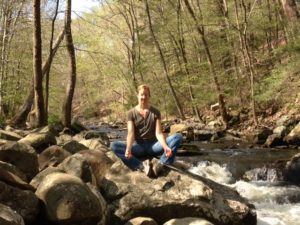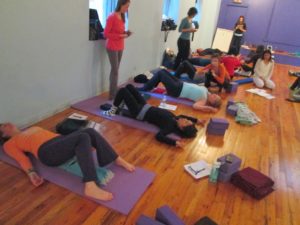
I know that I won’t be popular as I state this, but I love these last ditch efforts of Mother Nature to coat our world in white. My view may be myopic as I enjoy the snow from my home and do not have to drive out in it. My heart pours out to those that do have to go out. This is what I love – that Mother Nature is in charge. This keeps our Egos in check and ourselves in awe of what she can do with her power.
I felt the same way when I first saw some of the water ways of Yosemite, many years ago. I remember standing there taking in the powerful forces of water which were contained in the sandy embankments of the creek. But from the reports I heard from the rangers of major flooding, damage and loss of lives, I felt something shift in how I view nature. It was not fear, it was respect.
Nature’s bad reputation with the horrific hurricanes that seem to crop up year round and other natural disasters seem to amplify the fear factor. Respect of nature will put her in a different light. I recently went to the Banff Film Festival at Immaculata College, where short films were presented showing the human respecting nature in their work and play. Sure what some of the individuals did were scary and death defying but they did it with respect for the natural conditions that they were in. They also seemed to know that they too were part of nature and did their best to do no harm. They never felt separate from these forces of nature.
How can you respect yourself as this force of nature in whatever condition that you are in, pain, grief, sadness, elation, joy, etc.? How can you best do no harm to yourself in your body, with your thoughts and actions and beliefs? Get to the literal root of your being and your own nature.
Breath
Alternate Nostril Breath (Nadi Shodhana)
This breath invites the calm in, balancing both sides of our nasal passages and our brain. We tend to breath predominately with either the left or right nasal passage and we become unbalanced. A few minutes at the start of a class or practice, can merge the two hemispheres of the brain and allow you to become more receptive.
Breathing through the right or left nostrils gives different effects.
increases heart rate, increases verbal performance, stimulates left brain, increases rate of blinking
Left Nostril decreases heart rate, increases spatial performance, stimulates right brain, reduces rate of blinking,
The Practice: Find a comfortable seat or laying down. Using the right hand, bring the middle and index fingers to rest toward the palm. Alternatively, they can be placed at your third eye (forehead area). Begin with even breaths through both nostrils, gently close off right nostril, then inhale through left nostril and exhale through the right nostril. Gently close off left nostril, as you inhale through right and exhale through left. Keep the same count for both sides. That is one round. Repeat for 5 to 6 rounds or more. Tongue comes to rest on roof of mouth.
Other variations of this breath are:
- Retaining the breath after the inhale while keeping both nostrils gently closed.
- Extending the exhale longer than inhale
- Cessation of breath after the exhale, with only one nostril closed
Mental Nadi Shodhana. Mentally instruct the breath to come in and out through alternating nostrils. Can even visualize breathing in from one far away place and breathing out to another far away place (Mt. Everest (Inhale), African plains (Exhale)
Poses
Half Legs Up
 Props:
Props: 2 blocks, bolster, 2 blankets, eye and neck pillow
Benefits: increases circulation and helps venous and lymphatic flow from the lower body; relieves swelling and fatigue in the legs; helps relieve muscular skeletal stress in pelvis; quiets the mind and can help promote ease in meditation and sleep.
Use the 2 blocks, setting one at a lower height than the other, place bolster lengthwise on the blocks inclined. One leg will rest on the floor with a blanket covering and one leg will rest on the inclined bolster with blanket covering. Arms can stay at your side, move to Goddess (shown) or hands can rest at belly. cover yourself for more warmth and add an eye pillow to shut out the light for deeper relaxation.
Belly Down – Childs Pose Variation (Spinal Extension)
Benefits: relaxes the pelvis and shoulders, release back tension, extends the spine, lengthens legs, feet.
Props: 1 or 2 blankets rolled up like a sausage
Recline yourself over the rolled up blankets, making sure that the blankets are at the hip crease and upper thigh, not the stomach area. Head may be at center or turned to one side. Arms can be by your side or into Goddess arms or even rest your forehead on the hands. Long deep breaths to begin with and long exhalations to let the pelvis relax into the blankets. Add rolled up hand towels for under the ankles for even more release and lengthening. Stay for as long as you want and when ready to release, move slowly to Childs Pose.
Bridge Pose (Setu Bandhasana) & Variations for Spine Opening
(adding energy, vitalization)
Benefits: Expands the chest muscles, opens the lungs, balances the glands, quiets the nerves and releases tension in the nervous system, increases oxygen intake to the brain, can stimulate the immune system (thyroid)
Props: 4 blankets, neck roll, eye pillow, can also use bolster for more stretch
Extras: blanket for warmth
Lie on your back with knees bent and feet flat on the floor. Lift butt and slide the stack of 2 or 4 blankets under the base of your spine. Find a comfortable position, then let the upper back release on the floor. Arms are relaxed at sides or resting on belly. Feel chest and belly rise with each breath. Roll gently to one side when done and inhale up to seated.
 Props: 2 blocks, bolster, 2 blankets, eye and neck pillow
Props: 2 blocks, bolster, 2 blankets, eye and neck pillow



Leave A Comment